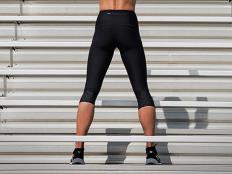
They look cool, come in a variety of fashionable colors and patterns, keep you warm at that in-between temperature, are easily discarded should you get too warm (and are not half as expensive as a technical shirt), and are trademarks for athletes including Allen Iverson and Paula Radcliffe.
Compression garments are one of the latest trends to hit the performance gear shelves. As with most trends that come and go in sports, it takes a while for the science to catch up with the practice. About five years ago, when compression gear first became popular as a potential ergogenic aid, there were very few published reports regarding their efficacy.
More: Prevent Running Injuries for Life
As a result, their use during competition was not endorsed by many clinicians, athletic trainers and physical therapists. However, due to their popularity and continued use by professional and recreational athletes, scientists have investigated the mechanisms behind the purported benefits of compression garments. As a result, several peer-reviewed papers have been published on the topic and it is certainly a topic worth revisiting.
What Does Compression Gear Do?
Clinically, compression gear is designed to deliver specific levels of pressure to the affected limb. Typical pressure ranges are from 20 to 40 millimeters of mercury, depending on the limb and the clinical indication.
Off the shelf stockings may deliver 30 to 40 millimeters of mercury of pressure whereas custom stockings deliver 40 millimeters of mercury pressure at the ankle, 36 millimeters of mercury at the lower calf, and 21 millimeters of mercury at the upper calf. These pressure levels are designed to enhance venous return and reduce edema in patients with various vein disorders.
- 1
- of
- 3
About the Author

Get ACTIVE on the Go


Couch to 5K®
The best way to get new runners off the couch and across the finish line of their first 5K.
Available for iOS | Android






Discuss This Article